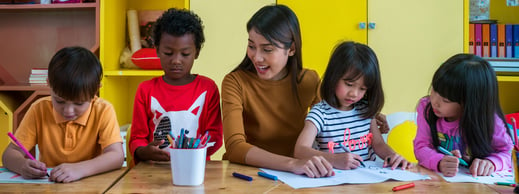
As part of our ongoing Interactions at the Heart of Healing work, I recently met with Amanda Wiliford, P.h.D. of the University of Virginia to talk about her work on improving Teacher-Child relationships. Below is a portion of our conversation. To hear more, register for her upcoming webinar, Cultivating Connections After Trauma: Relationship Equity in Your Classroom as part of our Trauma-Informed Care webinar series.
Can you talk about what you mean by that term relationship equity?

Amanda Wiliford: I think a lot of times when you talk to teachers about how they build teacher-child relationships in the classroom, teachers will say, “Well, I like all of the children in my classroom and I build strong relationships with all of them.” But if you flip it a little bit and you ask a teacher, “Think about the students in your classroom. Who is most connected to you and who might not be as connected to you?” teachers can very quickly think about kids who come to them more often…and who elicit stronger connections with their teachers. And so, the idea of thinking about the fact that relationships aren't equitable across a classroom then becomes very apparent to teachers. Think about what students might be missing if they're not strongly connected. We want to think about how you can make sure that every child gets to have the opportunity to build that connection with their teacher, even if it doesn't happen automatically.
What would you say to an educator that's has noticed that a child's withdrawn, but ascribes it to the student’s preferences?
Amanda Wiliford: We often take an observation of a behavior and want to figure out the meaning from it, so we attribute that behavior to a meaning, when we just don't know if that’s the case. I think teachers assume that when kids are playing by themselves often and they don't appear distressed.
And in fact, we do know that for kids who are feeling sad, depressed, or anxious, they might be feeling physiological distress, but you wouldn't see it behaviorally. So, it is important to check in and make an attempt.
How are awareness and responsiveness related to relationship equity an essential part of trauma-informed teaching?
Amanda Wiliford: I think part of it stems from understanding that when children experience trauma, that can undermine their ability to form strong connections because they are experiencing physiological stress. That can manifest itself either by being withdrawn or not being able to regulate that stress and acting out—being impulsive in the classroom in ways that can undermine the tendency of a teacher to make a connection with the student and vice-versa for the students to come to that teacher. Some forms of trauma make it less likely for a child to be able to trust an adult, so it requires the adult to make a very intentional effort to show that they are a safe and trusted adult in the classroom.
Let’s say I've noticed my children have had adverse experiences and that it manifests in their behaviors in the classroom, what do I do?
Amanda Wiliford: Be intentional about getting to know the student better in the classroom by spending time with them in a very child-directed way. A child-directed way means the child gets to lead the session and you have moved out of a teaching role. You communicate “I want to get to know you and I accept you unconditionally” in this role. We have an intervention called Banking Time, which is a set of four very simple strategies that allow a teacher to spend time with a student in a way that ensures that the interaction will be child-directed and where the teacher and the child can learn new things about one another.
We're talking about finding five or 10 minutes, a few times a week to do four things.
- Observe the child in an activity of their choice. We want teachers to sit back and watch or observe. What this does is take the teaching role away in an intentional way for teachers. As adults, we like to ask lots of questions of kids. But we don't want you to ask any questions at all. Questions are great teaching strategies, but they tend to then control the session. Instead, we want you to sit back and just watch what a child chooses to do. How do they approach the task? Do they initiate a conversation with you? Do they make eye contact with you? It gives the child space to decide how to approach their play with you or their interaction with you. It lets the child know that you are paying attention to them, that what they do matters in a way that doesn't involve any talking or any directing.
- Narrate what you see happening in your interactions with the child. You can narrate in multiple ways. If you're playing with blocks and they're stacking the blocks one on top of the other, you could say, “You're stacking the blocks one on top of the other.” You could also narrate by stacking blocks just like they're stacking blocks and we call that imitation. You reflect back what you see.
- Label emotions—positive, neutral, and negative emotions that you see during that play space or interaction time. Say the child is coloring and they get mad because maybe they can't draw the thing that they want to draw right and they start to break the crayons. In a classroom, you might say, “We don't break crayon, because we want everyone to be able to use them.” In a Banking Time session, you would say, “You are drawing that picture and it's frustrating you and you're breaking the crayons.” You wouldn't try to fix the drawing, you wouldn't say “let me help you”, you wouldn't try to distract. You would just describe what happened and label what you think.
- Develop a relational theme or make very explicit why the relationship matters to you and the student. We want the teacher to reflect and analyze what they think the child needs from the relationship. Why are you making this connection stronger? Why are you, as a teacher, investing in these sessions for yourself and the child? What do you think the child needs from you that the child is not getting right now? Examples might be, if a child never comes to you in the classroom when they're frustrated. a relational theme might be, “I am here when you need me.” Another theme that we've had teachers use is, “I'm always here to help you.”
View the entire Trauma-informed Care Webinar series and register for Amanda's webinar “Cultivating Connections After Trauma: Relationship Equity in Your Classroom”

